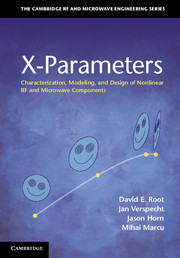Book contents
- Frontmatter
- Contents
- Preface
- Acknowledgments
- 1 S-parameters – a concise review
- 2 X-parameters – fundamental concepts
- 3 Spectral linearization approximation
- 4 X-parameter measurement
- 5 Multi-tone and multi-port cases
- 6 Memory
- Appendix A Notations and general definitions
- Appendix B X-parameters and Volterra theory
- Appendix C Parallel Hammerstein symmetry
- Appendix D Wide-band memory approximation
- Appendix E Solutions to exercises
- Index
- References
1 - S-parameters – a concise review
Published online by Cambridge University Press: 05 October 2013
- Frontmatter
- Contents
- Preface
- Acknowledgments
- 1 S-parameters – a concise review
- 2 X-parameters – fundamental concepts
- 3 Spectral linearization approximation
- 4 X-parameter measurement
- 5 Multi-tone and multi-port cases
- 6 Memory
- Appendix A Notations and general definitions
- Appendix B X-parameters and Volterra theory
- Appendix C Parallel Hammerstein symmetry
- Appendix D Wide-band memory approximation
- Appendix E Solutions to exercises
- Index
- References
Summary
Introduction
This chapter presents a concise treatment of S-parameters, meant primarily as an introduction to the more general formalism of X-parameters. The concepts of time invariance and spectral maps are introduced at this stage to enable an easier generalization to X-parameters in the ensuing chapters. The interpretations of S-parameters as calibrated measurements, intrinsic properties of the device under test (DUT), IP-secure component behavioral models, and composition rules for linear system design are presented. The cascade of two linear S-parameter components is considered as an example to be generalized to the nonlinear case later. The calculation of S-parameters for a transistor from a simple nonlinear device model is used as an example to introduce the concepts of (static) operating point and small-signal conditions, both of which must be generalized for the treatment of X-parameters.
S-parameters
Since the 1950s, S-parameters, or scattering parameters, have been among the most important of all the foundations of microwave theory and techniques.
S-parameters are easy to measure at high frequencies with a vector network analyzer (VNA). Well-calibrated S-parameter measurements represent intrinsic properties of the DUT, independent of the VNA system used to characterize it. Calibration procedures [1] remove systematic measurement errors and enable a separation of the overall values into numbers attributable to the device, independent of the measurement system used to characterize it. These DUT properties (gain, loss, reflection coefficient, etc.) are familiar, intuitive, and important [2]. Another key property of S-parameters is that the S-parameters of a composite system are completely determined from knowledge of the S-parameters of the constituent components and their connectivity. S-parameters provide the complete specification of how a linear component responds to an arbitrary signal. Therefore designs of linear systems with S-parameters are predictable with absolute certainty. S-parameters define a complete behavioral description of the linear component at the external terminals, independent of the detailed physics or specifics of the realization of the component. S-parameters can be shared between component vendors and system integrators freely, without the possibility that the component implementation can be reverse engineered, protecting IP and promoting sharing and reuse. Indeed, one may ask the question, “are S-parameters measurements, or do they constitute a model?” The answer is really “both.”
- Type
- Chapter
- Information
- X-ParametersCharacterization, Modeling, and Design of Nonlinear RF and Microwave Components, pp. 1 - 19Publisher: Cambridge University PressPrint publication year: 2013



